Analysis of Nurses' Job Satisfaction at Guangdong General Hospital
VerifiedAdded on 2023/06/11
|19
|4324
|125
Literature Review
AI Summary
This literature review explores the determinants of nurses' job satisfaction, focusing on a case study of Guangdong General Hospital in China. It begins by defining job satisfaction and examining methods for measuring it specifically among nurses. The review delves into situational theories, including Maslow's hierarchy of needs and Herzberg's two-factor theory, to provide a theoretical foundation. It then categorizes the determinants of job satisfaction into extrinsic job conditions (salary, supervision, workload, working conditions, interpersonal association, and administration), intrinsic job characteristics (achievement, feedback, work value, responsibility, individual growth, and job security), and individual characteristics (age, education, gender, position, and tenure). The review also discusses measures to improve nurses' job satisfaction, such as enhancing the practice environment, increasing nursing population, improving managerial support, and offering better compensation. Finally, it identifies a literature gap concerning research on nurses' job satisfaction in China, particularly focusing on specific determinants and hospital settings. The review concludes by emphasizing the importance of understanding and addressing these factors to improve nurse retention and overall healthcare quality.
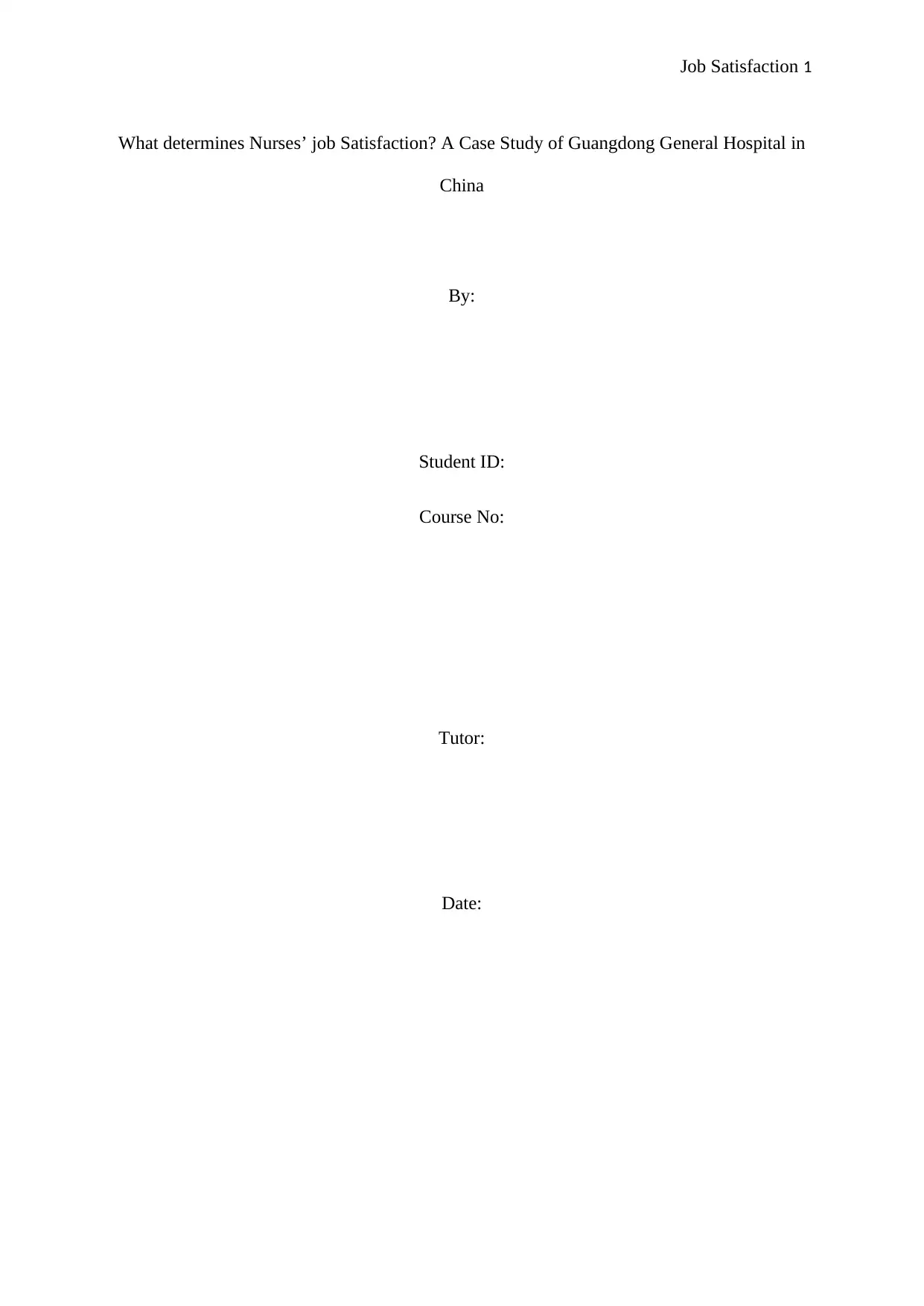
Job Satisfaction 1
What determines Nurses’ job Satisfaction? A Case Study of Guangdong General Hospital in
China
By:
Student ID:
Course No:
Tutor:
Date:
What determines Nurses’ job Satisfaction? A Case Study of Guangdong General Hospital in
China
By:
Student ID:
Course No:
Tutor:
Date:
Paraphrase This Document
Need a fresh take? Get an instant paraphrase of this document with our AI Paraphraser
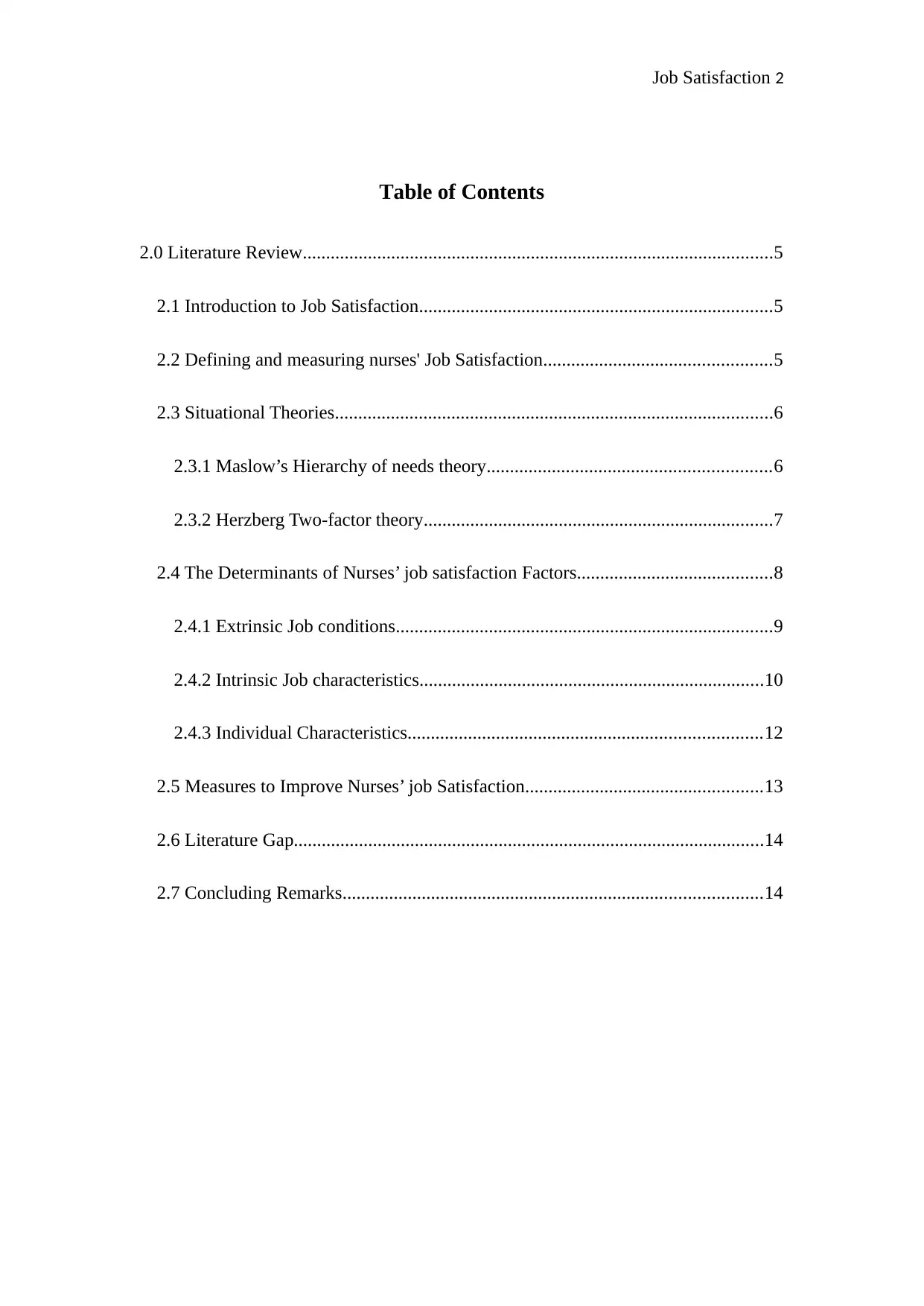
Job Satisfaction 2
Table of Contents
2.0 Literature Review.....................................................................................................5
2.1 Introduction to Job Satisfaction............................................................................5
2.2 Defining and measuring nurses' Job Satisfaction.................................................5
2.3 Situational Theories..............................................................................................6
2.3.1 Maslow’s Hierarchy of needs theory.............................................................6
2.3.2 Herzberg Two-factor theory...........................................................................7
2.4 The Determinants of Nurses’ job satisfaction Factors..........................................8
2.4.1 Extrinsic Job conditions.................................................................................9
2.4.2 Intrinsic Job characteristics..........................................................................10
2.4.3 Individual Characteristics............................................................................12
2.5 Measures to Improve Nurses’ job Satisfaction...................................................13
2.6 Literature Gap.....................................................................................................14
2.7 Concluding Remarks..........................................................................................14
Table of Contents
2.0 Literature Review.....................................................................................................5
2.1 Introduction to Job Satisfaction............................................................................5
2.2 Defining and measuring nurses' Job Satisfaction.................................................5
2.3 Situational Theories..............................................................................................6
2.3.1 Maslow’s Hierarchy of needs theory.............................................................6
2.3.2 Herzberg Two-factor theory...........................................................................7
2.4 The Determinants of Nurses’ job satisfaction Factors..........................................8
2.4.1 Extrinsic Job conditions.................................................................................9
2.4.2 Intrinsic Job characteristics..........................................................................10
2.4.3 Individual Characteristics............................................................................12
2.5 Measures to Improve Nurses’ job Satisfaction...................................................13
2.6 Literature Gap.....................................................................................................14
2.7 Concluding Remarks..........................................................................................14
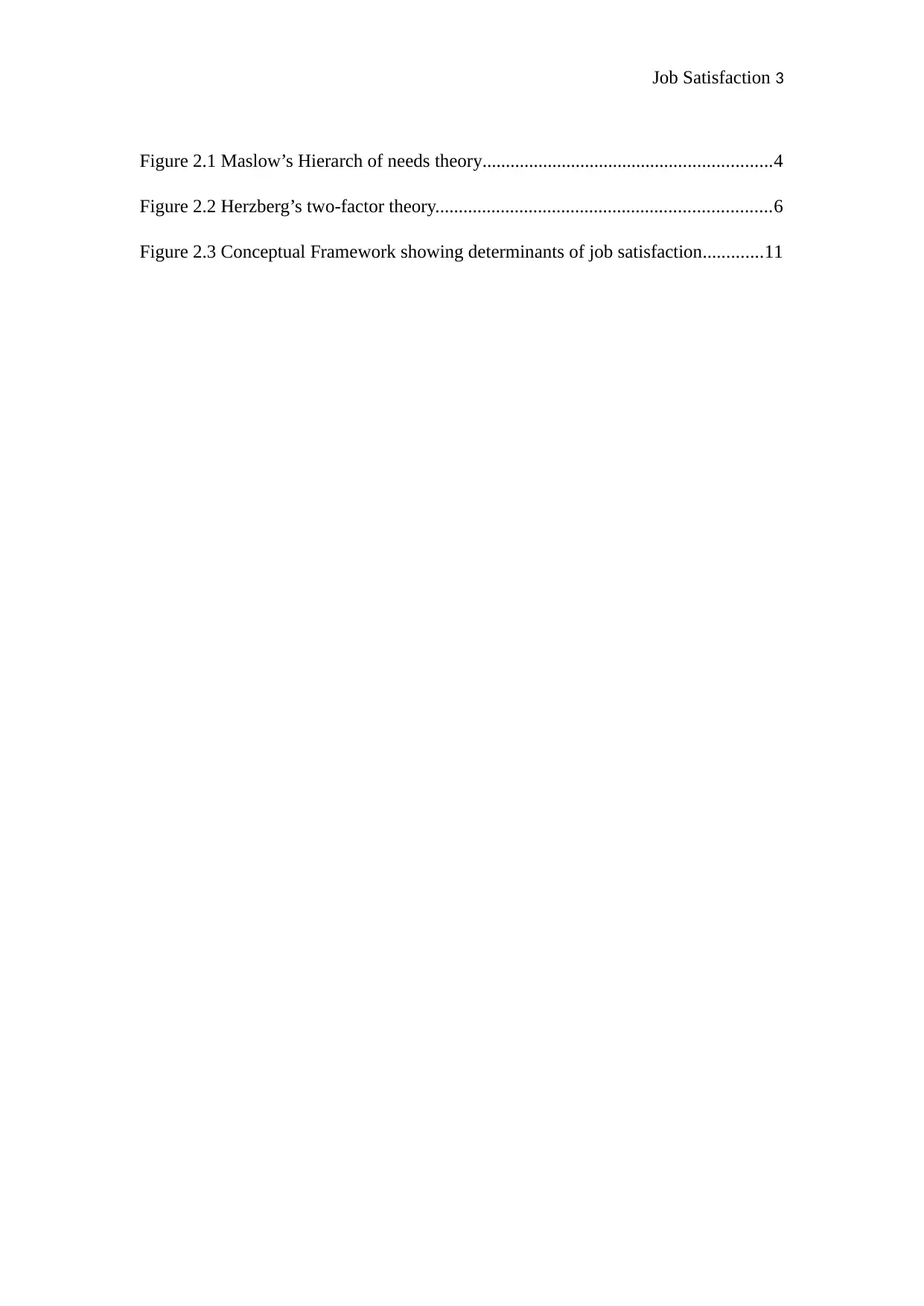
Job Satisfaction 3
Figure 2.1 Maslow’s Hierarch of needs theory..............................................................4
Figure 2.2 Herzberg’s two-factor theory........................................................................6
Figure 2.3 Conceptual Framework showing determinants of job satisfaction.............11
Figure 2.1 Maslow’s Hierarch of needs theory..............................................................4
Figure 2.2 Herzberg’s two-factor theory........................................................................6
Figure 2.3 Conceptual Framework showing determinants of job satisfaction.............11
⊘ This is a preview!⊘
Do you want full access?
Subscribe today to unlock all pages.

Trusted by 1+ million students worldwide
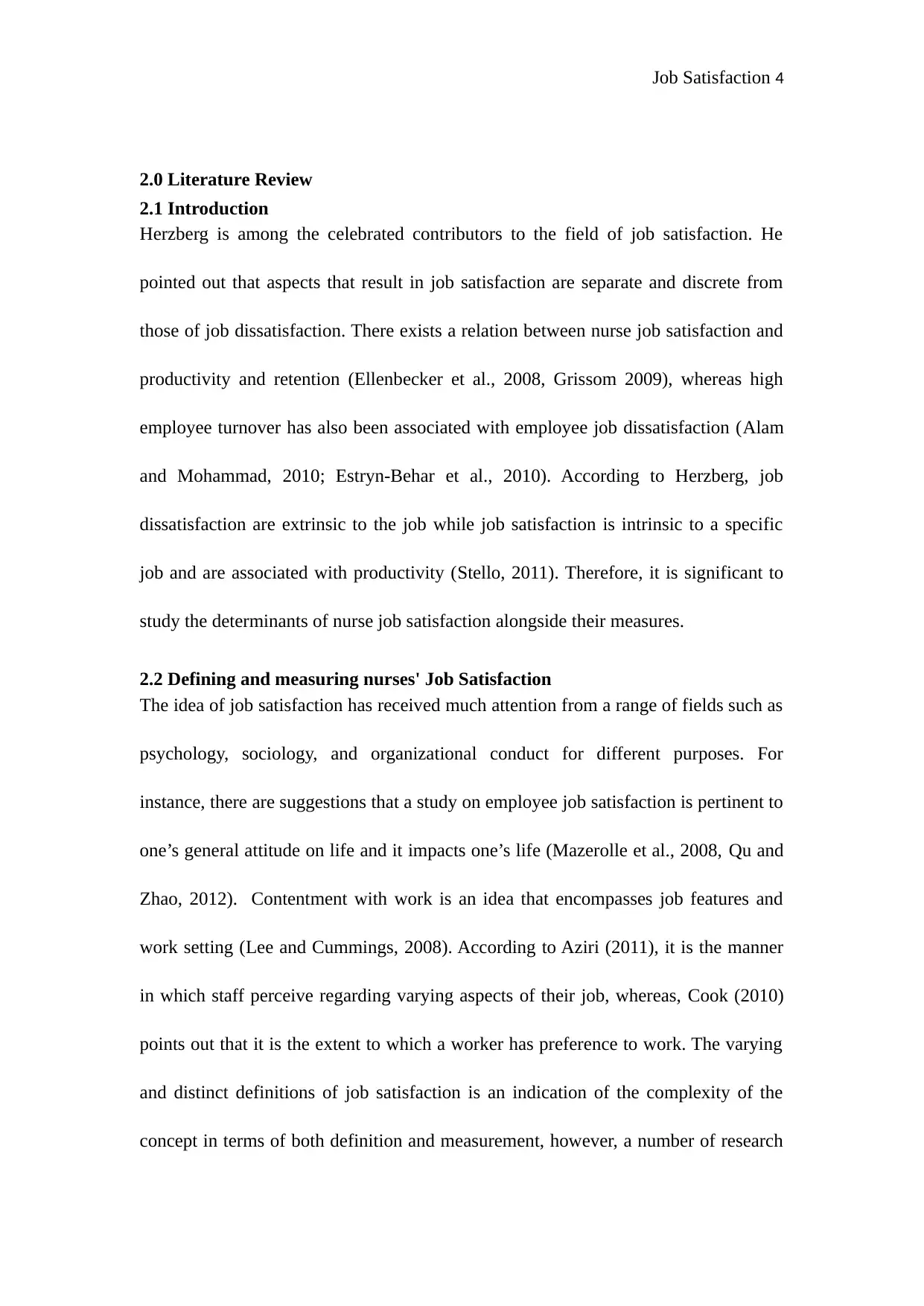
Job Satisfaction 4
2.0 Literature Review
2.1 Introduction
Herzberg is among the celebrated contributors to the field of job satisfaction. He
pointed out that aspects that result in job satisfaction are separate and discrete from
those of job dissatisfaction. There exists a relation between nurse job satisfaction and
productivity and retention (Ellenbecker et al., 2008, Grissom 2009), whereas high
employee turnover has also been associated with employee job dissatisfaction (Alam
and Mohammad, 2010; Estryn-Behar et al., 2010). According to Herzberg, job
dissatisfaction are extrinsic to the job while job satisfaction is intrinsic to a specific
job and are associated with productivity (Stello, 2011). Therefore, it is significant to
study the determinants of nurse job satisfaction alongside their measures.
2.2 Defining and measuring nurses' Job Satisfaction
The idea of job satisfaction has received much attention from a range of fields such as
psychology, sociology, and organizational conduct for different purposes. For
instance, there are suggestions that a study on employee job satisfaction is pertinent to
one’s general attitude on life and it impacts one’s life (Mazerolle et al., 2008, Qu and
Zhao, 2012). Contentment with work is an idea that encompasses job features and
work setting (Lee and Cummings, 2008). According to Aziri (2011), it is the manner
in which staff perceive regarding varying aspects of their job, whereas, Cook (2010)
points out that it is the extent to which a worker has preference to work. The varying
and distinct definitions of job satisfaction is an indication of the complexity of the
concept in terms of both definition and measurement, however, a number of research
2.0 Literature Review
2.1 Introduction
Herzberg is among the celebrated contributors to the field of job satisfaction. He
pointed out that aspects that result in job satisfaction are separate and discrete from
those of job dissatisfaction. There exists a relation between nurse job satisfaction and
productivity and retention (Ellenbecker et al., 2008, Grissom 2009), whereas high
employee turnover has also been associated with employee job dissatisfaction (Alam
and Mohammad, 2010; Estryn-Behar et al., 2010). According to Herzberg, job
dissatisfaction are extrinsic to the job while job satisfaction is intrinsic to a specific
job and are associated with productivity (Stello, 2011). Therefore, it is significant to
study the determinants of nurse job satisfaction alongside their measures.
2.2 Defining and measuring nurses' Job Satisfaction
The idea of job satisfaction has received much attention from a range of fields such as
psychology, sociology, and organizational conduct for different purposes. For
instance, there are suggestions that a study on employee job satisfaction is pertinent to
one’s general attitude on life and it impacts one’s life (Mazerolle et al., 2008, Qu and
Zhao, 2012). Contentment with work is an idea that encompasses job features and
work setting (Lee and Cummings, 2008). According to Aziri (2011), it is the manner
in which staff perceive regarding varying aspects of their job, whereas, Cook (2010)
points out that it is the extent to which a worker has preference to work. The varying
and distinct definitions of job satisfaction is an indication of the complexity of the
concept in terms of both definition and measurement, however, a number of research
Paraphrase This Document
Need a fresh take? Get an instant paraphrase of this document with our AI Paraphraser
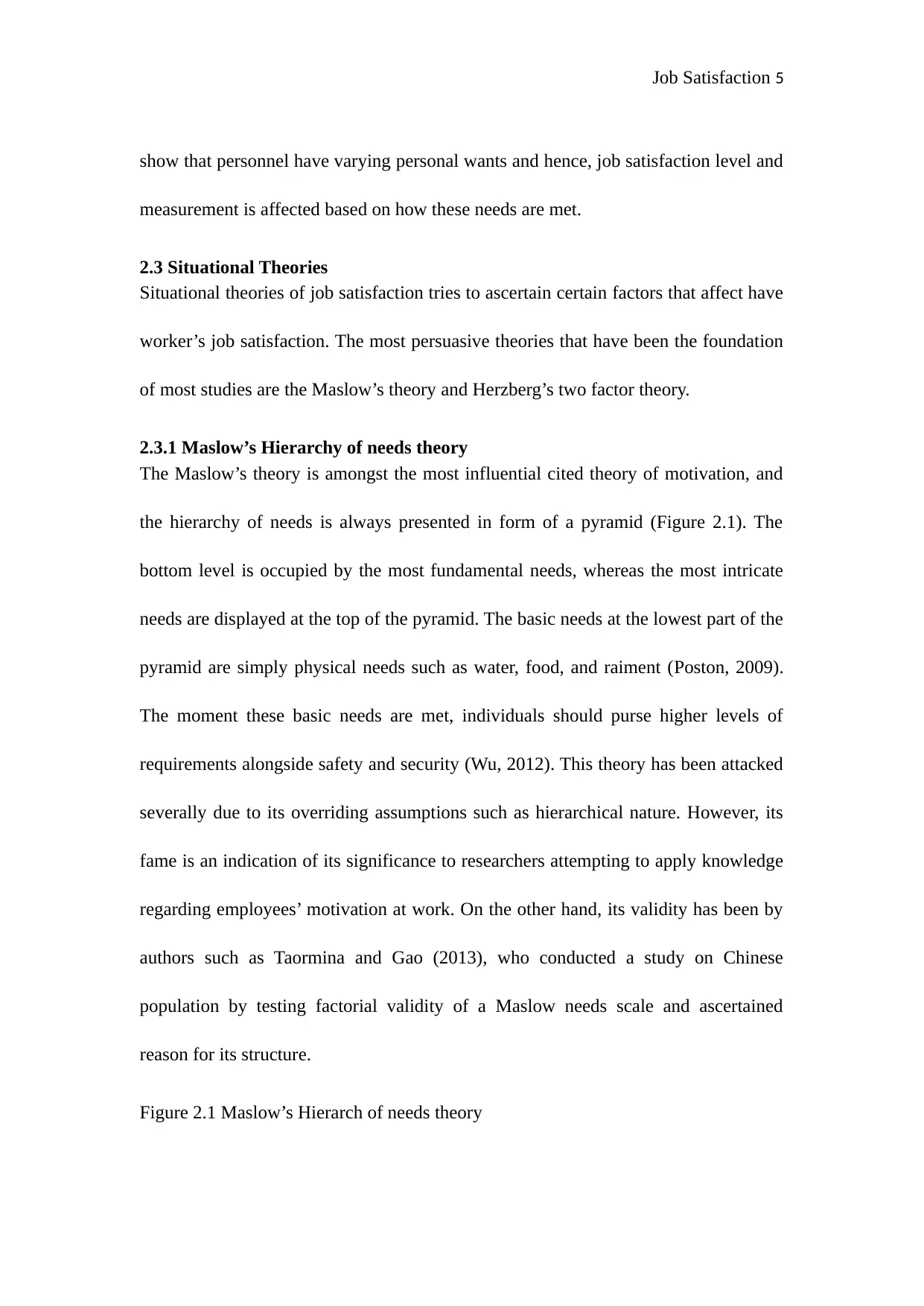
Job Satisfaction 5
show that personnel have varying personal wants and hence, job satisfaction level and
measurement is affected based on how these needs are met.
2.3 Situational Theories
Situational theories of job satisfaction tries to ascertain certain factors that affect have
worker’s job satisfaction. The most persuasive theories that have been the foundation
of most studies are the Maslow’s theory and Herzberg’s two factor theory.
2.3.1 Maslow’s Hierarchy of needs theory
The Maslow’s theory is amongst the most influential cited theory of motivation, and
the hierarchy of needs is always presented in form of a pyramid (Figure 2.1). The
bottom level is occupied by the most fundamental needs, whereas the most intricate
needs are displayed at the top of the pyramid. The basic needs at the lowest part of the
pyramid are simply physical needs such as water, food, and raiment (Poston, 2009).
The moment these basic needs are met, individuals should purse higher levels of
requirements alongside safety and security (Wu, 2012). This theory has been attacked
severally due to its overriding assumptions such as hierarchical nature. However, its
fame is an indication of its significance to researchers attempting to apply knowledge
regarding employees’ motivation at work. On the other hand, its validity has been by
authors such as Taormina and Gao (2013), who conducted a study on Chinese
population by testing factorial validity of a Maslow needs scale and ascertained
reason for its structure.
Figure 2.1 Maslow’s Hierarch of needs theory
Figure 1 Figure 2.1 Maslow’s Hierarch of needs theory
show that personnel have varying personal wants and hence, job satisfaction level and
measurement is affected based on how these needs are met.
2.3 Situational Theories
Situational theories of job satisfaction tries to ascertain certain factors that affect have
worker’s job satisfaction. The most persuasive theories that have been the foundation
of most studies are the Maslow’s theory and Herzberg’s two factor theory.
2.3.1 Maslow’s Hierarchy of needs theory
The Maslow’s theory is amongst the most influential cited theory of motivation, and
the hierarchy of needs is always presented in form of a pyramid (Figure 2.1). The
bottom level is occupied by the most fundamental needs, whereas the most intricate
needs are displayed at the top of the pyramid. The basic needs at the lowest part of the
pyramid are simply physical needs such as water, food, and raiment (Poston, 2009).
The moment these basic needs are met, individuals should purse higher levels of
requirements alongside safety and security (Wu, 2012). This theory has been attacked
severally due to its overriding assumptions such as hierarchical nature. However, its
fame is an indication of its significance to researchers attempting to apply knowledge
regarding employees’ motivation at work. On the other hand, its validity has been by
authors such as Taormina and Gao (2013), who conducted a study on Chinese
population by testing factorial validity of a Maslow needs scale and ascertained
reason for its structure.
Figure 2.1 Maslow’s Hierarch of needs theory
Figure 1 Figure 2.1 Maslow’s Hierarch of needs theory

Job Satisfaction 6
Source: Poston (2009)
2.3.2 Herzberg Two-factor theory
Herzberg’s theory differentiated dissatisfiers (elements that lead to dissatisfaction)
from satisfiers (aspects that lead to satisfaction) as shown in figure 2.2 below. Most
important is that unfulfilled hygiene factors can cause demotivation and
dissatisfaction. This is dependent on organizational policies, quality of supervision,
associations with other staff, individual life, salary, job security and working
conditions. However, unsatisfied but unmotivated cannot be ignored. The implication
of this is that for there to be improved job satisfaction, the administration has to center
on motivators such as making the work captivating, daunting, and individually
rewarding (Parvin, and Kabir, 2011). The motivational factors make up positive
Source: Poston (2009)
2.3.2 Herzberg Two-factor theory
Herzberg’s theory differentiated dissatisfiers (elements that lead to dissatisfaction)
from satisfiers (aspects that lead to satisfaction) as shown in figure 2.2 below. Most
important is that unfulfilled hygiene factors can cause demotivation and
dissatisfaction. This is dependent on organizational policies, quality of supervision,
associations with other staff, individual life, salary, job security and working
conditions. However, unsatisfied but unmotivated cannot be ignored. The implication
of this is that for there to be improved job satisfaction, the administration has to center
on motivators such as making the work captivating, daunting, and individually
rewarding (Parvin, and Kabir, 2011). The motivational factors make up positive
⊘ This is a preview!⊘
Do you want full access?
Subscribe today to unlock all pages.

Trusted by 1+ million students worldwide
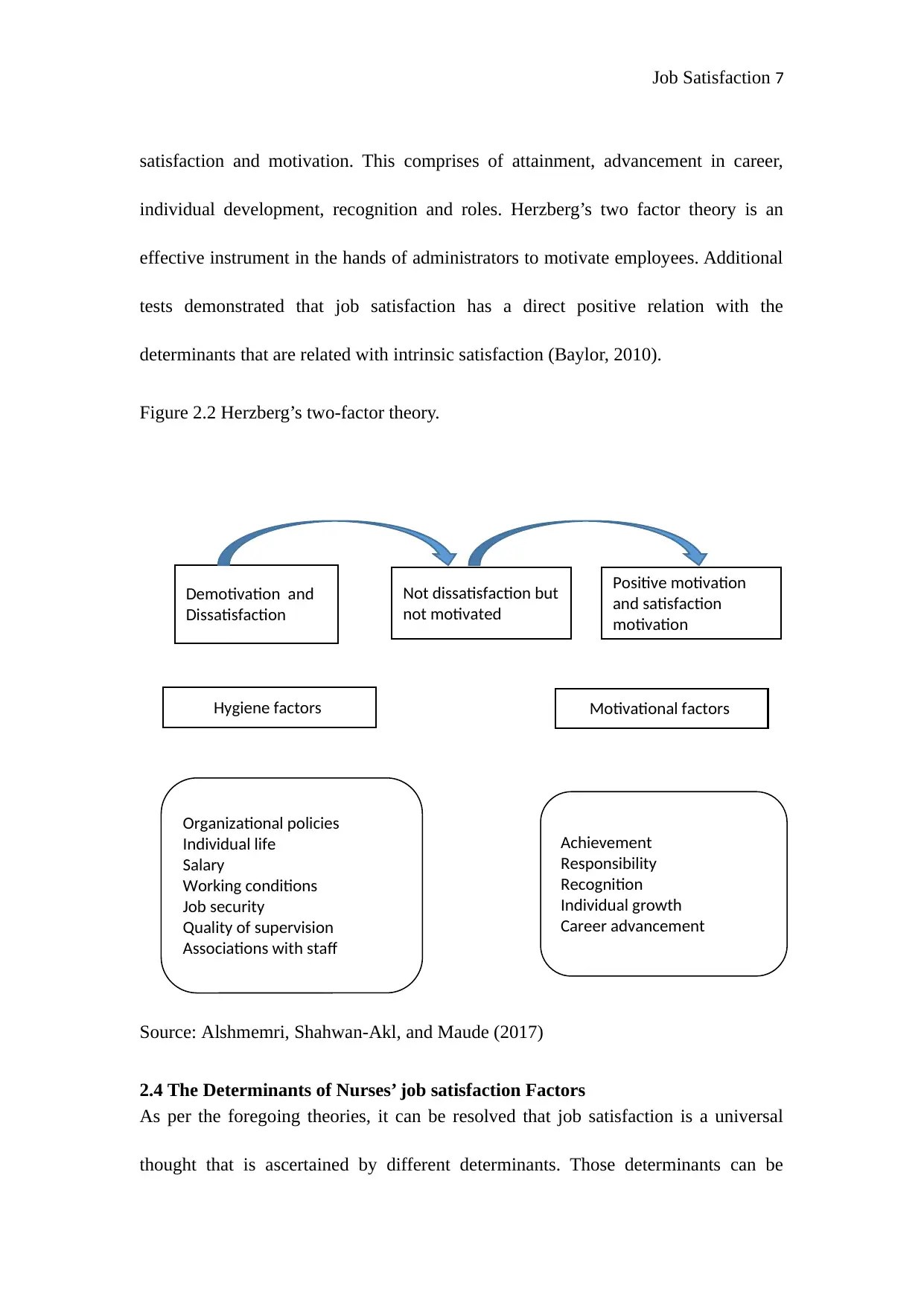
Job Satisfaction 7
satisfaction and motivation. This comprises of attainment, advancement in career,
individual development, recognition and roles. Herzberg’s two factor theory is an
effective instrument in the hands of administrators to motivate employees. Additional
tests demonstrated that job satisfaction has a direct positive relation with the
determinants that are related with intrinsic satisfaction (Baylor, 2010).
Figure 2.2 Herzberg’s two-factor theory.
Figure 2 Figure 2.2 Herzberg’s two-factor theory.
Source: Alshmemri, Shahwan-Akl, and Maude (2017)
2.4 The Determinants of Nurses’ job satisfaction Factors
As per the foregoing theories, it can be resolved that job satisfaction is a universal
thought that is ascertained by different determinants. Those determinants can be
Achievement
Responsibility
Recognition
Individual growth
Career advancement
Hygiene factors Motivational factors
Demotivation and
Dissatisfaction
Not dissatisfaction but
not motivated
Positive motivation
and satisfaction
motivation
Organizational policies
Individual life
Salary
Working conditions
Job security
Quality of supervision
Associations with staff
satisfaction and motivation. This comprises of attainment, advancement in career,
individual development, recognition and roles. Herzberg’s two factor theory is an
effective instrument in the hands of administrators to motivate employees. Additional
tests demonstrated that job satisfaction has a direct positive relation with the
determinants that are related with intrinsic satisfaction (Baylor, 2010).
Figure 2.2 Herzberg’s two-factor theory.
Figure 2 Figure 2.2 Herzberg’s two-factor theory.
Source: Alshmemri, Shahwan-Akl, and Maude (2017)
2.4 The Determinants of Nurses’ job satisfaction Factors
As per the foregoing theories, it can be resolved that job satisfaction is a universal
thought that is ascertained by different determinants. Those determinants can be
Achievement
Responsibility
Recognition
Individual growth
Career advancement
Hygiene factors Motivational factors
Demotivation and
Dissatisfaction
Not dissatisfaction but
not motivated
Positive motivation
and satisfaction
motivation
Organizational policies
Individual life
Salary
Working conditions
Job security
Quality of supervision
Associations with staff
Paraphrase This Document
Need a fresh take? Get an instant paraphrase of this document with our AI Paraphraser
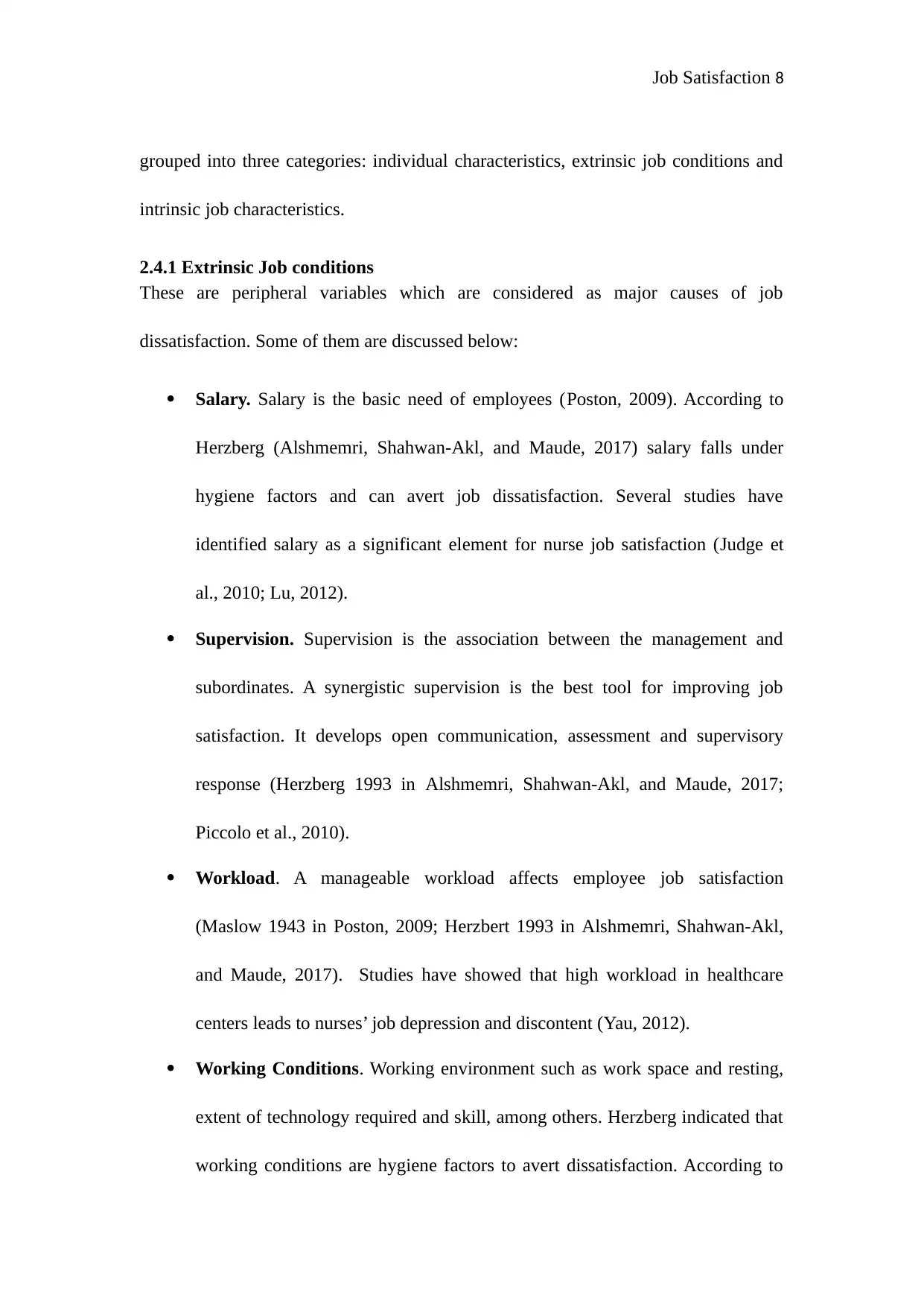
Job Satisfaction 8
grouped into three categories: individual characteristics, extrinsic job conditions and
intrinsic job characteristics.
2.4.1 Extrinsic Job conditions
These are peripheral variables which are considered as major causes of job
dissatisfaction. Some of them are discussed below:
Salary. Salary is the basic need of employees (Poston, 2009). According to
Herzberg (Alshmemri, Shahwan-Akl, and Maude, 2017) salary falls under
hygiene factors and can avert job dissatisfaction. Several studies have
identified salary as a significant element for nurse job satisfaction (Judge et
al., 2010; Lu, 2012).
Supervision. Supervision is the association between the management and
subordinates. A synergistic supervision is the best tool for improving job
satisfaction. It develops open communication, assessment and supervisory
response (Herzberg 1993 in Alshmemri, Shahwan-Akl, and Maude, 2017;
Piccolo et al., 2010).
Workload. A manageable workload affects employee job satisfaction
(Maslow 1943 in Poston, 2009; Herzbert 1993 in Alshmemri, Shahwan-Akl,
and Maude, 2017). Studies have showed that high workload in healthcare
centers leads to nurses’ job depression and discontent (Yau, 2012).
Working Conditions. Working environment such as work space and resting,
extent of technology required and skill, among others. Herzberg indicated that
working conditions are hygiene factors to avert dissatisfaction. According to
grouped into three categories: individual characteristics, extrinsic job conditions and
intrinsic job characteristics.
2.4.1 Extrinsic Job conditions
These are peripheral variables which are considered as major causes of job
dissatisfaction. Some of them are discussed below:
Salary. Salary is the basic need of employees (Poston, 2009). According to
Herzberg (Alshmemri, Shahwan-Akl, and Maude, 2017) salary falls under
hygiene factors and can avert job dissatisfaction. Several studies have
identified salary as a significant element for nurse job satisfaction (Judge et
al., 2010; Lu, 2012).
Supervision. Supervision is the association between the management and
subordinates. A synergistic supervision is the best tool for improving job
satisfaction. It develops open communication, assessment and supervisory
response (Herzberg 1993 in Alshmemri, Shahwan-Akl, and Maude, 2017;
Piccolo et al., 2010).
Workload. A manageable workload affects employee job satisfaction
(Maslow 1943 in Poston, 2009; Herzbert 1993 in Alshmemri, Shahwan-Akl,
and Maude, 2017). Studies have showed that high workload in healthcare
centers leads to nurses’ job depression and discontent (Yau, 2012).
Working Conditions. Working environment such as work space and resting,
extent of technology required and skill, among others. Herzberg indicated that
working conditions are hygiene factors to avert dissatisfaction. According to
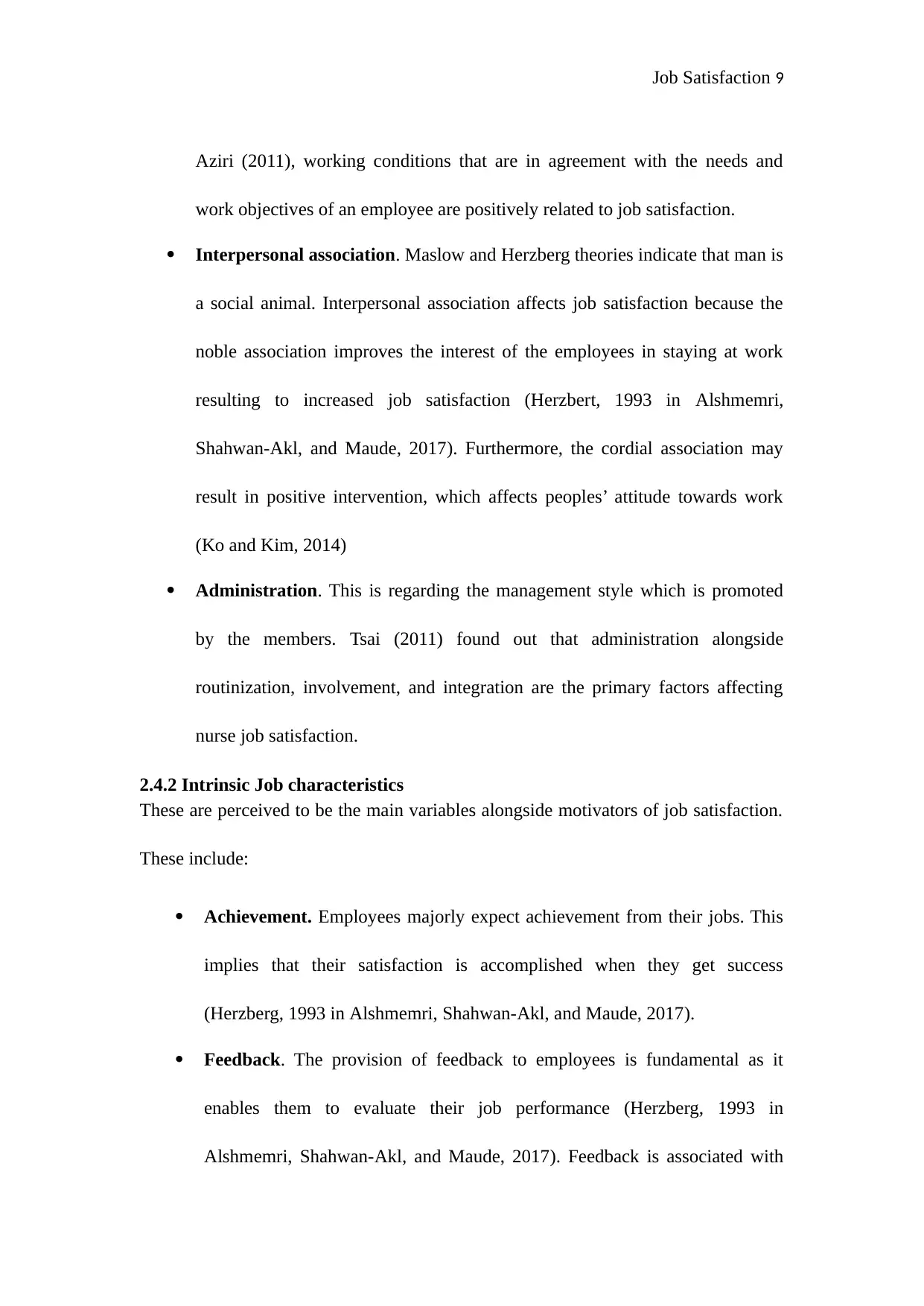
Job Satisfaction 9
Aziri (2011), working conditions that are in agreement with the needs and
work objectives of an employee are positively related to job satisfaction.
Interpersonal association. Maslow and Herzberg theories indicate that man is
a social animal. Interpersonal association affects job satisfaction because the
noble association improves the interest of the employees in staying at work
resulting to increased job satisfaction (Herzbert, 1993 in Alshmemri,
Shahwan-Akl, and Maude, 2017). Furthermore, the cordial association may
result in positive intervention, which affects peoples’ attitude towards work
(Ko and Kim, 2014)
Administration. This is regarding the management style which is promoted
by the members. Tsai (2011) found out that administration alongside
routinization, involvement, and integration are the primary factors affecting
nurse job satisfaction.
2.4.2 Intrinsic Job characteristics
These are perceived to be the main variables alongside motivators of job satisfaction.
These include:
Achievement. Employees majorly expect achievement from their jobs. This
implies that their satisfaction is accomplished when they get success
(Herzberg, 1993 in Alshmemri, Shahwan-Akl, and Maude, 2017).
Feedback. The provision of feedback to employees is fundamental as it
enables them to evaluate their job performance (Herzberg, 1993 in
Alshmemri, Shahwan-Akl, and Maude, 2017). Feedback is associated with
Aziri (2011), working conditions that are in agreement with the needs and
work objectives of an employee are positively related to job satisfaction.
Interpersonal association. Maslow and Herzberg theories indicate that man is
a social animal. Interpersonal association affects job satisfaction because the
noble association improves the interest of the employees in staying at work
resulting to increased job satisfaction (Herzbert, 1993 in Alshmemri,
Shahwan-Akl, and Maude, 2017). Furthermore, the cordial association may
result in positive intervention, which affects peoples’ attitude towards work
(Ko and Kim, 2014)
Administration. This is regarding the management style which is promoted
by the members. Tsai (2011) found out that administration alongside
routinization, involvement, and integration are the primary factors affecting
nurse job satisfaction.
2.4.2 Intrinsic Job characteristics
These are perceived to be the main variables alongside motivators of job satisfaction.
These include:
Achievement. Employees majorly expect achievement from their jobs. This
implies that their satisfaction is accomplished when they get success
(Herzberg, 1993 in Alshmemri, Shahwan-Akl, and Maude, 2017).
Feedback. The provision of feedback to employees is fundamental as it
enables them to evaluate their job performance (Herzberg, 1993 in
Alshmemri, Shahwan-Akl, and Maude, 2017). Feedback is associated with
⊘ This is a preview!⊘
Do you want full access?
Subscribe today to unlock all pages.

Trusted by 1+ million students worldwide
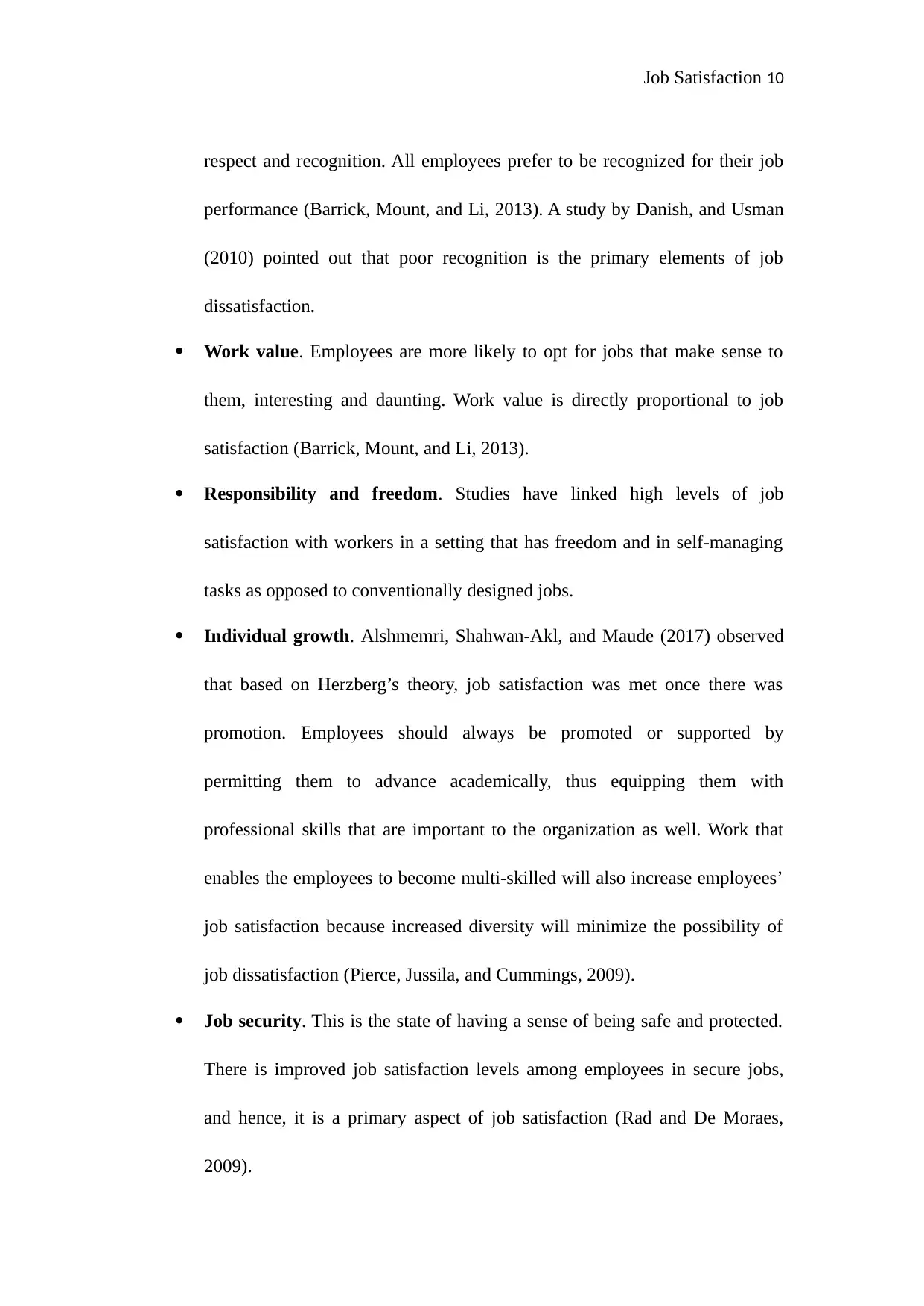
Job Satisfaction 10
respect and recognition. All employees prefer to be recognized for their job
performance (Barrick, Mount, and Li, 2013). A study by Danish, and Usman
(2010) pointed out that poor recognition is the primary elements of job
dissatisfaction.
Work value. Employees are more likely to opt for jobs that make sense to
them, interesting and daunting. Work value is directly proportional to job
satisfaction (Barrick, Mount, and Li, 2013).
Responsibility and freedom. Studies have linked high levels of job
satisfaction with workers in a setting that has freedom and in self-managing
tasks as opposed to conventionally designed jobs.
Individual growth. Alshmemri, Shahwan-Akl, and Maude (2017) observed
that based on Herzberg’s theory, job satisfaction was met once there was
promotion. Employees should always be promoted or supported by
permitting them to advance academically, thus equipping them with
professional skills that are important to the organization as well. Work that
enables the employees to become multi-skilled will also increase employees’
job satisfaction because increased diversity will minimize the possibility of
job dissatisfaction (Pierce, Jussila, and Cummings, 2009).
Job security. This is the state of having a sense of being safe and protected.
There is improved job satisfaction levels among employees in secure jobs,
and hence, it is a primary aspect of job satisfaction (Rad and De Moraes,
2009).
respect and recognition. All employees prefer to be recognized for their job
performance (Barrick, Mount, and Li, 2013). A study by Danish, and Usman
(2010) pointed out that poor recognition is the primary elements of job
dissatisfaction.
Work value. Employees are more likely to opt for jobs that make sense to
them, interesting and daunting. Work value is directly proportional to job
satisfaction (Barrick, Mount, and Li, 2013).
Responsibility and freedom. Studies have linked high levels of job
satisfaction with workers in a setting that has freedom and in self-managing
tasks as opposed to conventionally designed jobs.
Individual growth. Alshmemri, Shahwan-Akl, and Maude (2017) observed
that based on Herzberg’s theory, job satisfaction was met once there was
promotion. Employees should always be promoted or supported by
permitting them to advance academically, thus equipping them with
professional skills that are important to the organization as well. Work that
enables the employees to become multi-skilled will also increase employees’
job satisfaction because increased diversity will minimize the possibility of
job dissatisfaction (Pierce, Jussila, and Cummings, 2009).
Job security. This is the state of having a sense of being safe and protected.
There is improved job satisfaction levels among employees in secure jobs,
and hence, it is a primary aspect of job satisfaction (Rad and De Moraes,
2009).
Paraphrase This Document
Need a fresh take? Get an instant paraphrase of this document with our AI Paraphraser
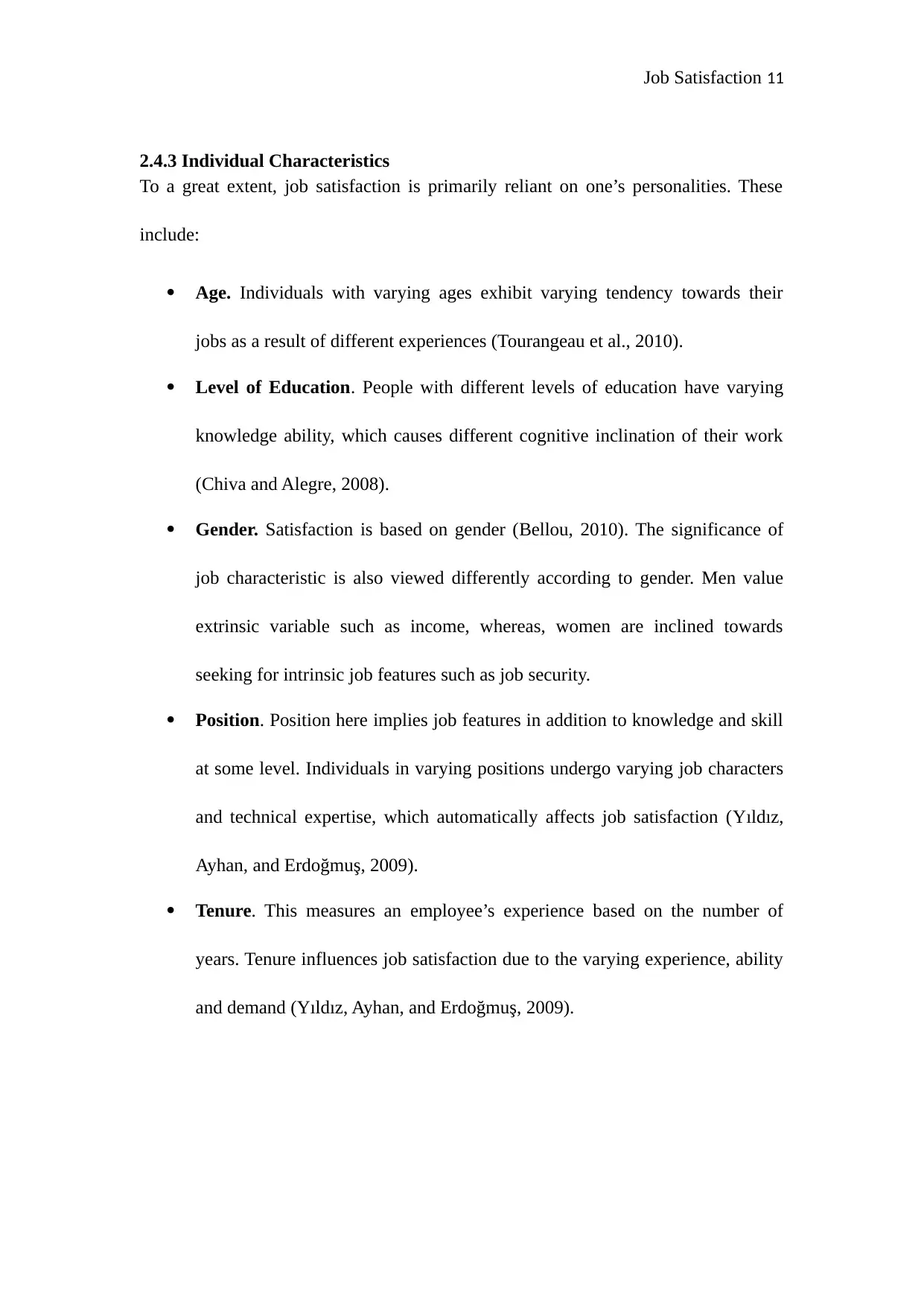
Job Satisfaction 11
2.4.3 Individual Characteristics
To a great extent, job satisfaction is primarily reliant on one’s personalities. These
include:
Age. Individuals with varying ages exhibit varying tendency towards their
jobs as a result of different experiences (Tourangeau et al., 2010).
Level of Education. People with different levels of education have varying
knowledge ability, which causes different cognitive inclination of their work
(Chiva and Alegre, 2008).
Gender. Satisfaction is based on gender (Bellou, 2010). The significance of
job characteristic is also viewed differently according to gender. Men value
extrinsic variable such as income, whereas, women are inclined towards
seeking for intrinsic job features such as job security.
Position. Position here implies job features in addition to knowledge and skill
at some level. Individuals in varying positions undergo varying job characters
and technical expertise, which automatically affects job satisfaction (Yıldız,
Ayhan, and Erdoğmuş, 2009).
Tenure. This measures an employee’s experience based on the number of
years. Tenure influences job satisfaction due to the varying experience, ability
and demand (Yıldız, Ayhan, and Erdoğmuş, 2009).
2.4.3 Individual Characteristics
To a great extent, job satisfaction is primarily reliant on one’s personalities. These
include:
Age. Individuals with varying ages exhibit varying tendency towards their
jobs as a result of different experiences (Tourangeau et al., 2010).
Level of Education. People with different levels of education have varying
knowledge ability, which causes different cognitive inclination of their work
(Chiva and Alegre, 2008).
Gender. Satisfaction is based on gender (Bellou, 2010). The significance of
job characteristic is also viewed differently according to gender. Men value
extrinsic variable such as income, whereas, women are inclined towards
seeking for intrinsic job features such as job security.
Position. Position here implies job features in addition to knowledge and skill
at some level. Individuals in varying positions undergo varying job characters
and technical expertise, which automatically affects job satisfaction (Yıldız,
Ayhan, and Erdoğmuş, 2009).
Tenure. This measures an employee’s experience based on the number of
years. Tenure influences job satisfaction due to the varying experience, ability
and demand (Yıldız, Ayhan, and Erdoğmuş, 2009).
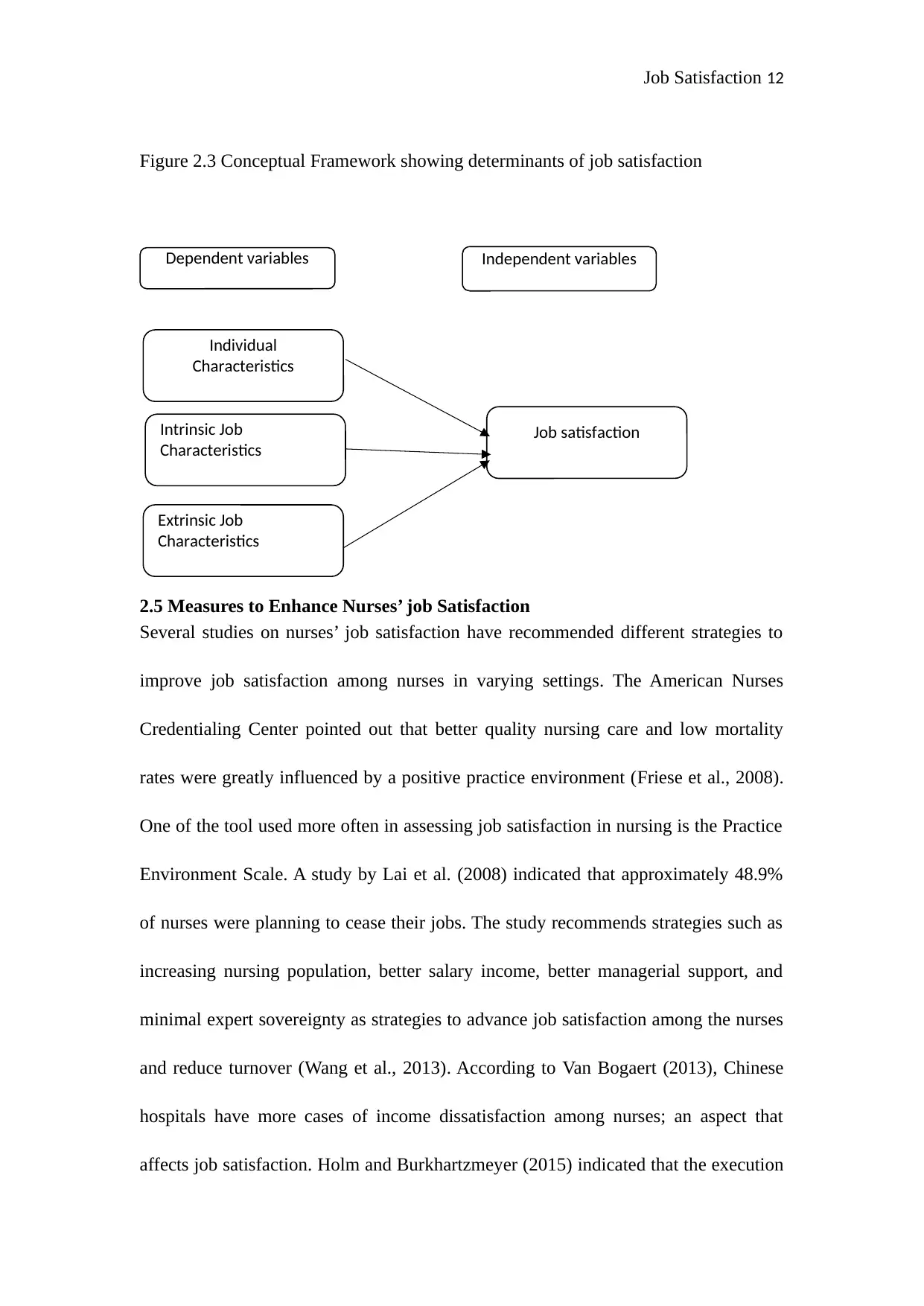
Job Satisfaction 12
Figure 2.3 Conceptual Framework showing determinants of job satisfaction
Figure 3 Figure 2.3 Conceptual Framework showing determinants of job satisfaction
2.5 Measures to Enhance Nurses’ job Satisfaction
Several studies on nurses’ job satisfaction have recommended different strategies to
improve job satisfaction among nurses in varying settings. The American Nurses
Credentialing Center pointed out that better quality nursing care and low mortality
rates were greatly influenced by a positive practice environment (Friese et al., 2008).
One of the tool used more often in assessing job satisfaction in nursing is the Practice
Environment Scale. A study by Lai et al. (2008) indicated that approximately 48.9%
of nurses were planning to cease their jobs. The study recommends strategies such as
increasing nursing population, better salary income, better managerial support, and
minimal expert sovereignty as strategies to advance job satisfaction among the nurses
and reduce turnover (Wang et al., 2013). According to Van Bogaert (2013), Chinese
hospitals have more cases of income dissatisfaction among nurses; an aspect that
affects job satisfaction. Holm and Burkhartzmeyer (2015) indicated that the execution
Individual
Characteristics
Intrinsic Job
Characteristics
Extrinsic Job
Characteristics
Job satisfaction
Dependent variables Independent variables
Figure 2.3 Conceptual Framework showing determinants of job satisfaction
Figure 3 Figure 2.3 Conceptual Framework showing determinants of job satisfaction
2.5 Measures to Enhance Nurses’ job Satisfaction
Several studies on nurses’ job satisfaction have recommended different strategies to
improve job satisfaction among nurses in varying settings. The American Nurses
Credentialing Center pointed out that better quality nursing care and low mortality
rates were greatly influenced by a positive practice environment (Friese et al., 2008).
One of the tool used more often in assessing job satisfaction in nursing is the Practice
Environment Scale. A study by Lai et al. (2008) indicated that approximately 48.9%
of nurses were planning to cease their jobs. The study recommends strategies such as
increasing nursing population, better salary income, better managerial support, and
minimal expert sovereignty as strategies to advance job satisfaction among the nurses
and reduce turnover (Wang et al., 2013). According to Van Bogaert (2013), Chinese
hospitals have more cases of income dissatisfaction among nurses; an aspect that
affects job satisfaction. Holm and Burkhartzmeyer (2015) indicated that the execution
Individual
Characteristics
Intrinsic Job
Characteristics
Extrinsic Job
Characteristics
Job satisfaction
Dependent variables Independent variables
⊘ This is a preview!⊘
Do you want full access?
Subscribe today to unlock all pages.

Trusted by 1+ million students worldwide
1 out of 19
Related Documents
Your All-in-One AI-Powered Toolkit for Academic Success.
+13062052269
info@desklib.com
Available 24*7 on WhatsApp / Email
![[object Object]](/_next/static/media/star-bottom.7253800d.svg)
Unlock your academic potential
Copyright © 2020–2026 A2Z Services. All Rights Reserved. Developed and managed by ZUCOL.




